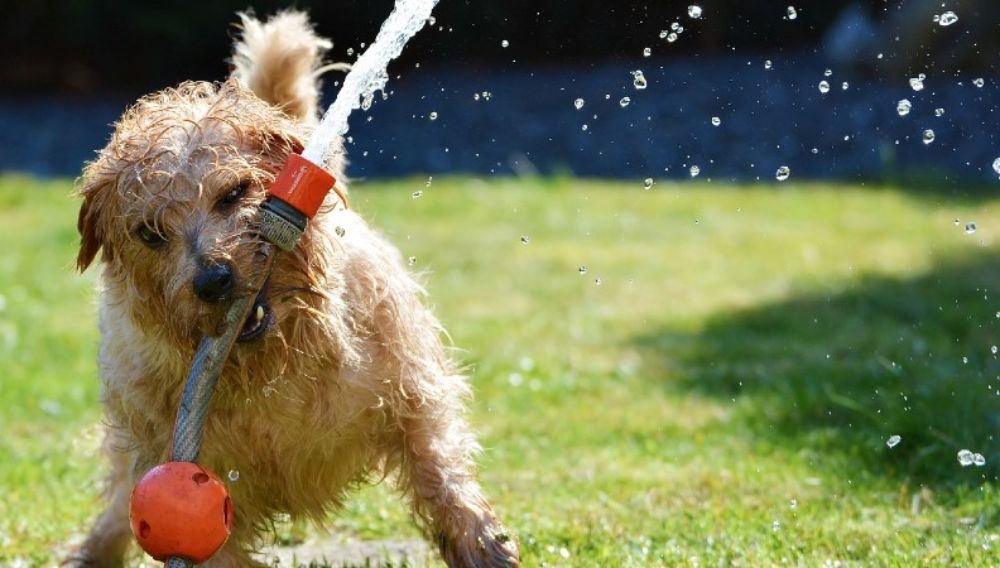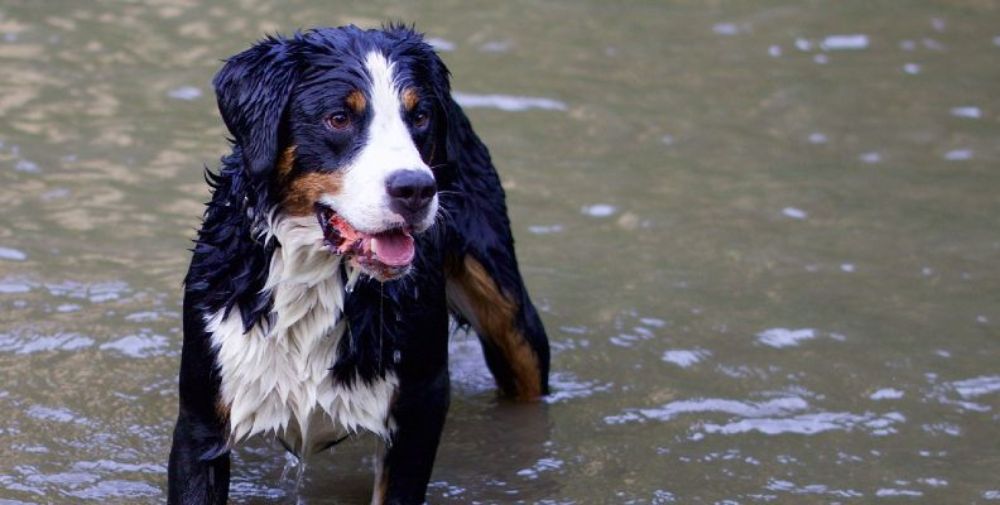
If it was up to your dog, they would run and play all day long, but it’s important to make sure your canine pal has everything they need to stay fit and healthy in the heat of the summer sun.
To help you keep your dog in cool condition this summer season, our vet expert friends at Vetstream and our in-house Vet Dr Anna Foreman, have put together all the information you need on how to keep dogs cool in summer.
Watch our video from Dr Anna and follow our expert tips on keeping your dog cool in the summer heat. Plus knowing what to look out for if they start to overheat, including the signs of heatstroke in dogs and dehydration.
Top 5 Tips to Keep Dogs Cool in Summer
The best way to keep dogs cool in hot weather is to always be prepared. Whether that's having damp towels at the ready, making sure your dog has access to water bowls in every room or keeping the curtains and blinds closed, it's better to be prepared.
Whether you’re at home in the garden or heading out for the day, you should always aim to have everything you need to create a safe place for your dog. Knowing how to keep your dog cool outside is especially important during summer months as shaded spots, cooling mats and fresh water can make a big difference.
To do this, check out our handy tips on how to keep your dogs cool outside:
1. Have Plenty of Fresh Water at the Ready
Wherever you go when you’re walking dogs in hot weather, take plenty of water with you. Your dog can quickly become dehydrated if they don’t drink enough and that can lead to serious health issues.
When you're at home, always make sure their water bowl is regularly replenished with fresh cool water. You can always try dropping a couple of ice cubes in to cool it down that little bit more for them. Make sure the cubes are an appropriate size for your dog, otherwise they could be a choking hazard.
If you've got one, a paddling pool in the garden can also be a nice place for your dog to chill out. Just make sure to keep an eye on them and keep the water clear of bugs as best you can.
2. Provide a Cool, Shady Place
If your dog loves to race around during the daytime, ensure they have a cool, shady place to relax when they get too warm. Without respite they can easily become overheated and dehydrated.
If you have air conditioning or a fan, you can leave that on for them in a shady room to help keep them cool.
3. Don’t Over Exercise Them
If they had their way, most dogs – especially the really energetic ones - would run around all day long. But keep an eye on them and try not to let them overexert themselves. This is especially important when it comes to games, because most dogs will continue to play, even when they’re too hot.
Large dogs, especially those with heavy, thick coats designed to keep them warm in cold climates can find hot weather distressing, so only let them play when it’s cooler. And be extra careful with breeds that are brachycephalic (flat-faced), like boxers and bulldogs. These dogs are not efficient at panting and may find breathing difficult after exercising, especially in the heat.
Always avoid walking your dog in the heat of day, aim for early morning or evening walks, and try to stay in the shade. Hot pavements can cause pain, blisters and even burns to their sensitive paw pads.
4. Never Lock Your Dog in a Car
Never leave your dog in a car. NEVER! Not even for a minute!
Dogs can easily be at risk of heatstroke, and cars can very quickly turn into a heat box when left in the sun. Car temperatures can also reach dangerous levels in the shade, leaving the windows open a tiny bit definitely isn’t enough.
Heatstroke can be extremely dangerous for dogs and sometimes fatal, so make sure you don’t leave them even for a few minutes.
5. Walk by Open Water or the Seaside
A good idea when you’re walking dogs in the summer is to let them take a cooling dip in some open water. Watch out for tides though if you’re at the seaside and be sure to wash off any salt water when they come out. Not all dogs are natural swimmers, so don’t throw them in if they’re not very enthusiastic about it.
Remember that there’s a risk of salt poisoning in dogs if they drink too much sea water, so keep an eye on them.
Signs can be seen with very small amounts of salt consumed, including vomiting, diarrhoea, wobbliness, weakness, thirst and excessive drinking, amongst others. If you think your dog has salt poisoning, call your vet for advice.

Signs of Dehydration, Exhaustion Heat Stroke in Dogs
A dog that’s over heated can suffer from heat exhaustion, heatstroke and in extreme cases, even death. If it’s hot outside and you’re concerned for your dog’s health, look out for these tell-tale signs of dog heatstroke include that mean they need to cool down and see a vet.
1. Dry Mouth and Nose
This is a sign of dehydration and means your dog needs water immediately, just give them small amounts of water to drink every few minutes. You can also test it by gently pulling on the skin on the back of your dog’s neck. If it springs back into place they’re hydrated, if it takes a long time to return to its original position, your dog is dehydrated.
2. Disorientation
This is a sign your dog is overheating. Look out for loud panting, followed by confusion and eventually collapse.
3. Sickness
If your dog begins to suffer from vomiting or diarrhoea during a really hot day, it’s very likely they’re overheating. They’ll need emergency attention, so speak to your vet immediately.
4. Gum Discoloration
Your dog’s gums can go bright red or even blue if they’re too hot, so act fast if you notice something that’s not right.
If you spot these signs in your dog, you must get veterinary attention as soon as possible. These signs can quickly be followed by collapse, seizures, coma and even death.
What to Do if Your Dog Overheats
If you see any of the symptoms of overheating above, you should do three things:
- Move your dog to a cool place and put cool, wet towels under their neck, tummy and groin.
- Apply cool water on their ears and paws. The water shouldn’t be too cold but cool tap temperature. Never use ice-cold water. A cool fan can also be used.
- Go to your vet as soon as possible. If possible, ask someone else to contact your vet ahead to let them know you’re on your way so they can prepare for your dog’s arrival. Your dog may have heatstroke which is potentially fatal, and will need urgent treatment.
How Your Vet Will Treat Your Dog
At the surgery your vet will use cooling baths, fans and may administer cooling fluids into the blood, and a cooling enema. After their body temperature has been reduced, blood tests may be taken. These tests will check for any damage that’s been done to your pet’s organs like the kidneys and liver.
Dogs that survive heatstroke may need to stay in intensive care afterwards. In intensive care they can be monitored for any aftereffects like blood clotting disorders.
Heatstroke in dogs is a very serious condition and can be fatal in as little as 20 minutes. It requires urgent emergency veterinary treatment. However, with care and attention when the weather is hot, you can prevent your dog overheating and developing heatstroke. So, follow the tips above and keep your dog safe this summer!
For more tips on caring for your dog, check out the Everypaw blog at All Things Pet.
Everypaw Dog Insurance
Everypaw's Dog Insurance comes with 24/7 unlimited access to vets and vet nurses that can help with your pet's health, care, nutrition and behaviour. So you can rest assured your pup will be well looked after.
Content provided from Vetstream's Vetlexicon Canis - www.vetstream.com/treat/canis
Vetlexicon is the world’s largest peer-reviewed online clinical reference source. All our content is written and peer-reviewed by over 1,000 of the world’s leading veterinarians, ensuring relevance, accuracy and quality.
- Vetstream Ltd, Kate Murphy, Poppy Gant (online) Heat stroke. In: Vetlexicon Canis. Vetstream Ltd, UK. Website: https://www.vetlexicon.com/canis/internal-medicine/client-factsheets/heat-stroke
- Nicola Bates, Vetstream Ltd (online) Beach hazards. In: Vetlexicon Canis. Vetstream Ltd, UK. Website: https://www.vetlexicon.com/canis/owner-information/client-factsheets/beach-hazards
- Nicola Bates, Kate Murphy (online) Salt (sodium chloride) poisoning in dogs. In: Vetlexicon Canis. Vetstream Ltd, UK. Website: https://www.vetlexicon.com/canis/client-information/client-factsheets/salt-sodium-chloride-poisoning-in-dog